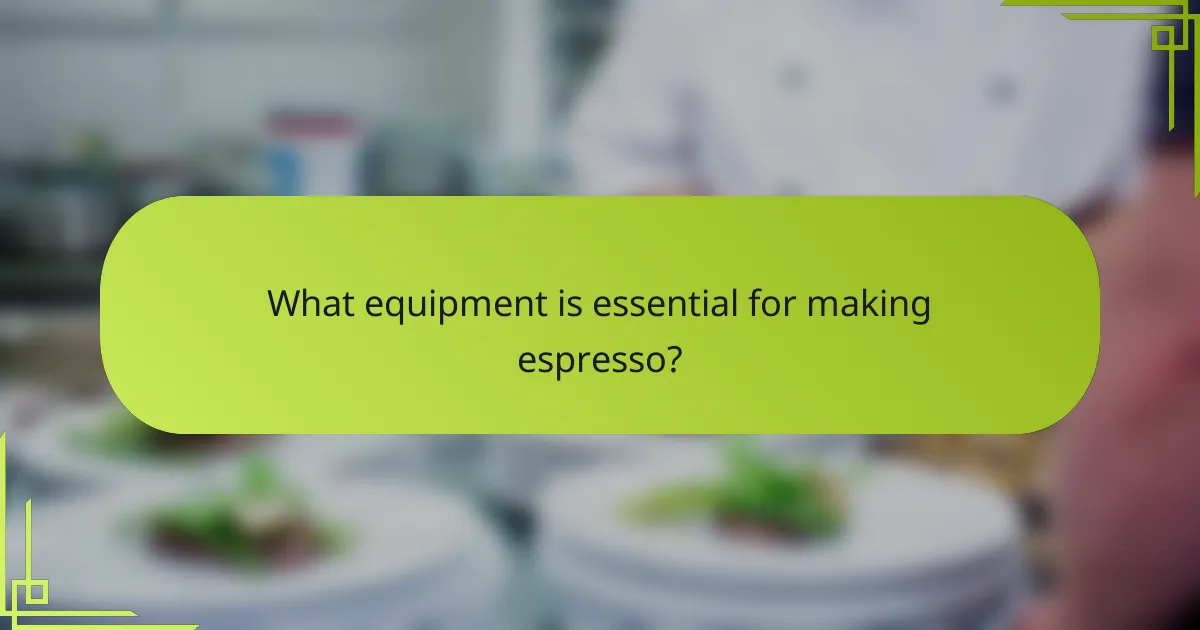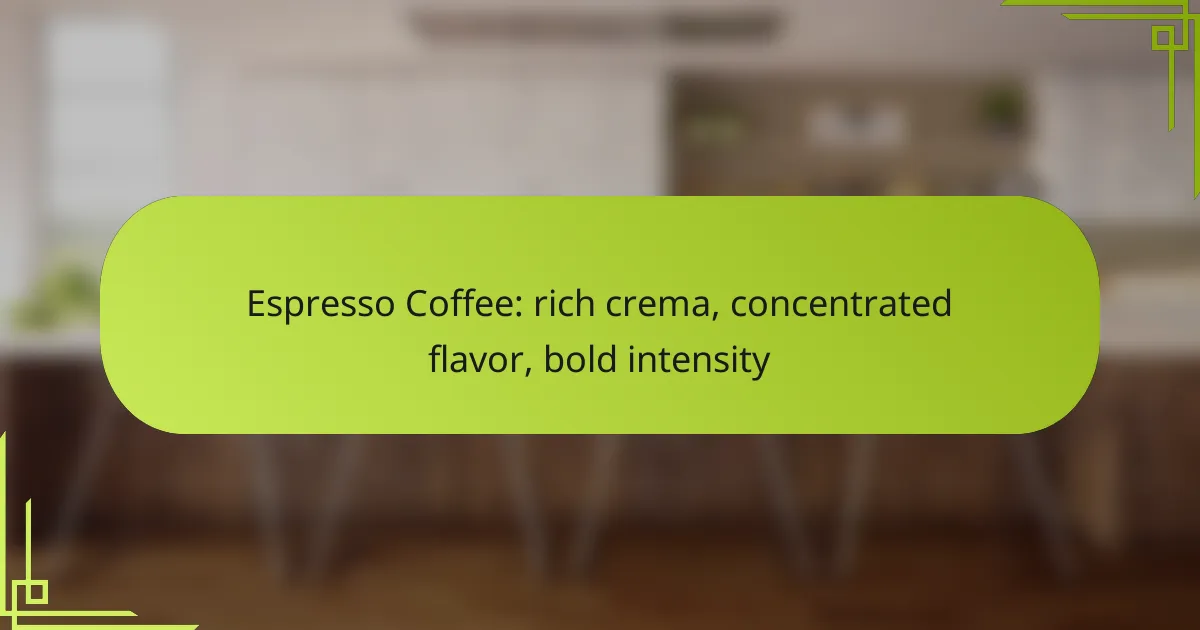Espresso coffee is renowned for its rich crema, concentrated flavor, and bold intensity, making it a favorite among coffee enthusiasts. The brewing process and specific extraction techniques contribute to its unique profile, delivering a robust beverage that offers a quick energy boost. With the right equipment and beans, anyone can enjoy the rich experience that espresso has to offer.

How to brew the perfect espresso in major cities
Brewing the perfect espresso involves selecting the right equipment, beans, and techniques tailored to your location. Major cities often have unique coffee cultures and resources that can enhance your espresso experience.
Espresso machine recommendations
Choosing the right espresso machine is crucial for achieving a rich and bold flavor. Consider machines from brands like Breville, De’Longhi, or Rancilio, which offer a range of options from entry-level to professional-grade. Look for features like a built-in grinder, temperature control, and pressure gauges to help you fine-tune your brew.
In cities like New York or London, you can find specialty shops that offer high-quality machines and expert advice. For those on a budget, consider semi-automatic machines that allow for more control without breaking the bank.
Best coffee beans for espresso
The choice of coffee beans significantly impacts the flavor of your espresso. Look for beans that are specifically labeled for espresso, often characterized by a darker roast and a blend of Arabica and Robusta varieties. Popular options include beans from regions like Brazil, Colombia, and Ethiopia, which provide a balance of sweetness and acidity.
In cities with vibrant coffee scenes, such as Seattle or Melbourne, local roasters often offer unique blends that can elevate your espresso. Experiment with different beans to find the flavor profile that suits your palate best.
Brewing techniques for rich crema
To achieve a rich crema, start with fresh, finely ground coffee and ensure your espresso machine is properly calibrated. Aim for a brewing time of around 25 to 30 seconds, which allows for optimal extraction of flavors and oils.
Pay attention to the tamping pressure; a consistent 30 pounds of pressure is recommended to create an even coffee bed. Additionally, preheating your machine and using filtered water can enhance the quality of your espresso and its crema.

What are the benefits of espresso coffee?
Espresso coffee offers several benefits, including a high caffeine concentration, a rich flavor profile, and a bold intensity that appeals to many coffee enthusiasts. These characteristics make espresso a popular choice for those seeking a quick energy boost and a robust coffee experience.
High caffeine concentration
Espresso is known for its high caffeine concentration, typically containing about 63 mg of caffeine per shot, which is significantly more than regular brewed coffee when measured ounce for ounce. This makes it an efficient choice for those looking for a quick pick-me-up without consuming large volumes of liquid.
When considering caffeine intake, it’s essential to be mindful of personal tolerance levels. For most adults, a moderate caffeine consumption of up to 400 mg per day is generally considered safe, which translates to roughly six shots of espresso. However, individual sensitivity can vary widely.
Rich flavor profile
The flavor profile of espresso is rich and complex, characterized by a balance of sweetness, bitterness, and acidity. This concentration of flavors is a result of the brewing process, which forces hot water through finely-ground coffee at high pressure, extracting essential oils and compounds that contribute to its distinctive taste.
Espresso can serve as the base for various coffee drinks, such as lattes, cappuccinos, and macchiatos, allowing for versatility in flavor combinations. Experimenting with different coffee beans and roast levels can further enhance the richness of the espresso experience, offering a range of tasting notes from fruity to nutty to chocolatey.

What are the key attributes of espresso coffee?
Espresso coffee is characterized by its rich crema, concentrated flavor, and bold intensity. These attributes stem from the brewing process and the specific techniques used to extract the coffee, resulting in a unique and robust beverage.
Crema quality
The crema of an espresso is the golden, frothy layer that forms on top during brewing. High-quality crema is a sign of a well-extracted shot, indicating freshness and proper brewing techniques. Ideal crema should be thick, velvety, and persist for several minutes.
To achieve excellent crema, use freshly ground coffee beans and ensure the coffee is tamped evenly in the portafilter. Avoid using stale coffee, as it can lead to a thin or nonexistent crema.
Flavor intensity
Espresso is known for its concentrated flavor, which is often described as bold and complex. The intensity comes from the high coffee-to-water ratio and the brewing method, which extracts oils and soluble compounds effectively. A typical espresso shot has a rich, full-bodied taste with a balance of sweetness and acidity.
When tasting espresso, look for flavor notes that can range from fruity to nutty, depending on the coffee origin. Experimenting with different beans can enhance your experience, as various roasts will yield distinct flavor profiles.
Brewing pressure
Brewing pressure is crucial in espresso preparation, typically set around 9 bars. This pressure forces hot water through the coffee grounds, extracting flavors and oils rapidly. Consistent pressure is key to achieving a balanced shot with optimal crema and flavor.
To maintain proper brewing pressure, ensure your espresso machine is calibrated correctly and that the coffee is tamped firmly. Inconsistent pressure can lead to over-extraction or under-extraction, affecting the overall quality of the espresso.

How does espresso compare to other coffee types?
Espresso is a concentrated coffee beverage brewed by forcing hot water through finely-ground coffee beans, resulting in a rich crema and bold flavor. Compared to other coffee types, espresso typically has a stronger taste and higher caffeine concentration per ounce, making it distinct in both preparation and experience.
Espresso vs. drip coffee
Espresso and drip coffee differ primarily in their brewing methods and flavor profiles. Drip coffee is made by allowing hot water to pass through coarsely ground coffee, resulting in a milder taste and larger volume, typically served in cups of 240 ml or more.
In contrast, a standard espresso shot is about 30 ml, delivering a more intense flavor and thicker crema. While drip coffee is often consumed in larger quantities, espresso is enjoyed in smaller sips, emphasizing its concentrated richness.
Espresso vs. French press
The French press method involves steeping coarsely ground coffee in hot water before pressing down a plunger to separate the grounds, producing a full-bodied coffee with a distinct texture. This method allows for more oils and sediment to remain in the brew, resulting in a different mouthfeel compared to espresso.
Espresso, on the other hand, uses pressure to extract flavors quickly, yielding a smoother and creamier drink. While both methods can produce rich flavors, espresso’s concentrated nature makes it a preferred choice for those seeking a quick caffeine boost or a base for drinks like lattes and cappuccinos.

What equipment is essential for making espresso?
To make quality espresso, you need a few key pieces of equipment: an espresso machine, a grinder, and some essential accessories. Each component plays a crucial role in extracting the rich crema and concentrated flavor that characterize a great espresso.
Espresso machines
Espresso machines are the heart of the espresso-making process. They come in various types, including manual, semi-automatic, and fully automatic, each offering different levels of control over the brewing process. When choosing a machine, consider factors such as pressure consistency, temperature stability, and ease of use.
High-quality machines typically operate at around 9 bars of pressure, which is essential for proper extraction. Brands like Breville, Rancilio, and La Marzocco are well-regarded in the espresso community for their reliability and performance.
Grinders
A good grinder is vital for achieving the right coffee grind size, which significantly impacts the flavor and crema of your espresso. Burr grinders are preferred over blade grinders because they provide a uniform grind, essential for consistent extraction. Look for grinders that allow you to adjust the grind size easily.
When grinding for espresso, aim for a fine consistency, similar to table salt. This ensures optimal extraction time, typically around 25 to 30 seconds for a double shot. Popular grinder brands include Baratza and Eureka.
Accessories for espresso preparation
Essential accessories for espresso preparation include a tamper, a scale, and a milk frother. A tamper is used to compress the coffee grounds evenly in the portafilter, which is crucial for a balanced extraction. Choose a tamper that fits your portafilter snugly for best results.
A digital scale helps you measure the coffee dose accurately, ensuring consistency in your shots. A milk frother or steam wand is important if you enjoy milk-based drinks like lattes or cappuccinos. Investing in quality accessories can greatly enhance your espresso-making experience.

What are common mistakes when brewing espresso?
Common mistakes when brewing espresso include using the wrong grind size, incorrect water temperature, and improper tamping. These factors can significantly affect the flavor and quality of the espresso, leading to a disappointing cup.
Using the wrong grind size
The grind size of the coffee beans is crucial for brewing espresso. If the grind is too coarse, the water will flow through too quickly, resulting in a weak and under-extracted shot. Conversely, a grind that is too fine can cause over-extraction, leading to bitterness.
A good rule of thumb is to aim for a fine grind, similar to table salt. Experimenting with slight adjustments can help you find the perfect balance for your specific espresso machine and beans.
Incorrect water temperature
Water temperature plays a vital role in espresso extraction. Ideally, the water should be between 90°C and 96°C (194°F to 205°F). Water that is too hot can scorch the coffee, while water that is too cool can lead to under-extraction.
Using a thermometer or an espresso machine with a built-in temperature control can help ensure that you are brewing at the optimal temperature for the best flavor profile.
Improper tamping
Tamping is the process of compressing the coffee grounds in the portafilter. If tamping is uneven or too light, it can create channels for water to flow through, resulting in an uneven extraction. On the other hand, tamping too hard can restrict water flow, leading to over-extraction.
A consistent tamping pressure of around 15-20 kg (33-44 lbs) is recommended. Using a level tamper can help achieve an even surface, ensuring a uniform extraction for a rich and flavorful espresso.










